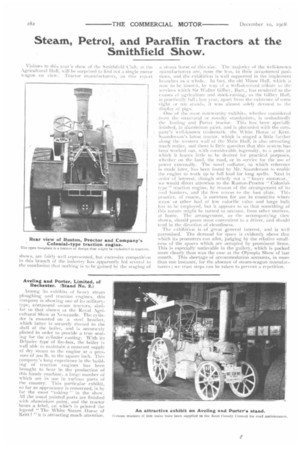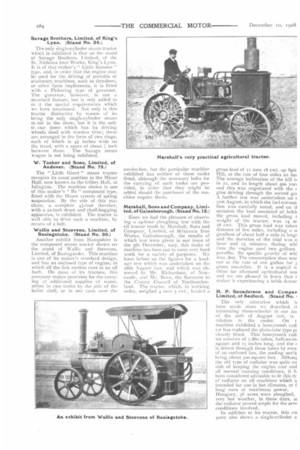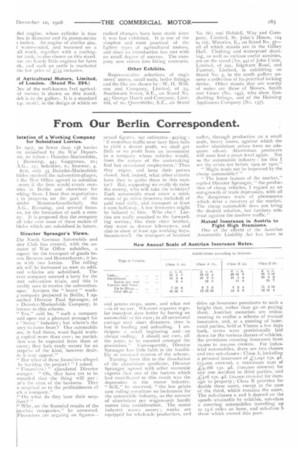Steam, Petrol, and Paraffin Tractors at the Smithfield Show.
Page 16

Page 17

Page 18

Page 19

If you've noticed an error in this article please click here to report it so we can fix it.
Visitors to this year's show of the Smithfield Gut), at the Agricultural [Tall, will be surprised to find not a single motor wagon on view. Tractor manufacturers, as this report shows, are fairly well represented, but excessive competition in this branch of the industry has apparently led several to the conclusion that nothing is to be gained by the staging of
a steam horse of this size. The majority of the well-known manufacturers are, none the less, in their accustomed positions, and the exhibition is well supported in the implement branches as a whole. In fact, the old Minor I lall, which is now to be known, by way of a well-deserved tribute to the services which Sir Walter Gilbev, Bart., has rendered to the causes 1)1 agriculture and stock-raising, as the Gilbey Hall, is practically full; last year, apart from the existence of some eight or ten stands, it was almost solely devoted to the display of pigs. One of the most noteworthy exhibits, whether considered from the structural or novelty standpoints, is undoubtedly the Aveling and Porter tractor. This has been specially finished, in aluminium paint, and is placarded with the coinpany.,s well-known trademarkthe White Horse of Kent. Saunderson's latest tractor, which is staged a little further along the western wall of the Main Hall, is also attracting much notice, mind there is little question that this system has been worked out, with considerable ingenuity, to a point at which it leaves little to be desired for practical purposes, whether on the land, the road, or in service for the use of power externally. The novel radiator, to which reference is made later, has been found by Mr. Saunderson to enable the engine to work up to full load for long spells. Next in order of interest, though strictly not a " heavy motorcar,we would direct attention to the Ruston-Proctor "
Colonialtype " traction engine, by reason of the arrangement of its coal bunkers, and the free access to the foot plate. This practice, of course, is common for use in countries where straw or other fuel of low calorific value and large bulk has to be employed, but it appears to us that something of this nature might be turned to account, from other motives, at home. The arrangement, as the accompanying view shows, should prove roost convenient to a driver, and should tend in the direction of cleanliness.
The exhibition is of great general interest, and is well patronised. The demand for space is evidently above that which its promoters can allot, judging by the relative smallness of the spaces which are occupied by prominent firms. 'This is especially noticeable in the gallery, which is packed more closely than was the case at the Olympia Show of last month. This shortage of accommodation accounts, in more than one instance, for the absence of steam-wagon manufacturers; we trust steps can be taken to prevent a repetition.
Aveling and Porter, Limited, of Rochester. (Stand No. 2.)
111011g its exhibits of heavy steam ploughingand traction engines, this company is showing one of its militarytype, compound steam tractors, similar to that shown at the Royal Agricultural Show at Newcastle. The evlin_ (ler is mounted on a steel bracket, which latter is securely riveted to the shell of the boiler, and is accurately planed in order to provide a true seating for the cylinder casting. With its Belpaire type of fire-box, the boiler is well able to maintain a constant supply of dry steam to the engine at a pressure of zi)o lb. to the square inch. This company's long experience in the building of traction engines has been brought to bear in the production of this handy machine, a large number of which are in use in various parts of the country. This particular exhibit, so far as appearance is concerned, is by fatthe most "taking" in the show. .111 the usual painted parts are finished with aluminium paint, and the tractor bears a label, on which is printed the legend " The White Steam Horse of Kent " it is attracting much attention.
Clayton and Shuttleworth, Limited, of Lincoln. (Stand No. 28.)
One of this company's compound tractors, built .for the Wooliner Estate Brick Works Company, Limited, is shown on this stand, The machine is a repeat order for that company. We learn that a similar engine has just been inn-chased by Messrs. E. Sharpe and Sons, of Blandford. A full description of this model was given in our issue of the 26th March last. It is one of the two governed compound engines which are exhibited at this show ; the governor is of the Pickering type. Extra water tanks are carried at each side of the boiler barrel, and a third tank extends under the barrel as far forward as the turntable. The number of trades where this particular make of tractor is employed now includes building cent rdctors, furniture removers, general carriers, brick manufacturers, shipowners, export agents, quarry owners, timber merchants, and travelling showmen, and, so far as its economical working is concerned, we have had one case brought to our notice where the cost for the fuel worked out at less than half the amount required to pnwide corn for the half 41ozen horses \cinch it replaced, whilst in every other respect the tractor proved itself equally adv:intageous and ectinomical. We might mention that the machine exhibited is provided with this maker's new type of geared feed pump; this has been found much more satisfactory than the old type, which was driven direct from the crankshaft.
Richard Garrett and Sons, Limited, of Leiston. (Stand No. 21.)
A gorgeously-linished steam tractor for showmen's use is exhibited on this maker's stand. It is one of the regular Garrett compounds, fitted with a Pickering governor. A steel-plate bracket. which extends forward from the smokebox, carries a dynamo, and, when required, this dynamo is driven by a belt from the dywheel of the engine. A long canopy is fitted, in order to protect from the weather all parts of the tractor and dynamo.
John Fowler and Company, of Leeds. (Stand No. 27.1
The one tractor which interests us On this maker's stand is the two-cylinder comptiand, which has been built to the order of Mr. H. Frost, Removal Contractor. of Dorchester. Likc that exhibited on Aveling and Porter's stand, it is provided with a lire-box of the Belpaire type, and also works at a pressure oi 2oo lb. to the square inch. We reproduce, herewith, an illustration of this e\hibit, which is an excellent ex ample of the splendid workmanship which is put into the products from Fowler 's works. No detail SVCITIS to have !teen too trivial to receive the careful consideration of both the designing and the ■korks departments of John Fowler and Company, Limited. The gearing is most carefully enclosed, in order to .protect ii front dust, and this also applies to the worm and worm wheel of the steering gear. The cylinder dimensions are : high pressure, inches; low pressure, 7 inches ; pistonstroke, 8 inches. The engin<, is rated to develop ibb.h.p. The company is not exhibiting one of its three-cylinder compounds of the " David " type.
Ransomes, Sims and Jefferies, of Ipswich. (Stand No. 5.)
This company hos a very representative collection of its manufactures, and included is one of the tractors which was shown for the first time at the Royal Agricultural Society's Show at Newcastle, in Julv last. It has a compound engine, and, generally, is constructed on the lines of this well-known maker's heavier types of road engines. Auxiliary side tanks are provided. This machine has ratheran unusual amount of " tail," but this feature allows of a large fuel bunker behind the driver, and also permits the lilting of an extralarge water tank below the foot-plate.
Savage Brothers, Limited, of King's Lynn. tStand No. 24.), The only single-cylinder steam tractor which is exhibited is that on the stand of Savage Brothers, Limited, of the St. Nicholas iron Works, King's Lynn. It is of that maker's " Little Samson " type, and, in order that the engine may be used for the driving of portable or stationary machines, such as threshers, or other farm implements, it is fitted with a Pickering type of governor. The governor, however, is not a standard feature, but is only added to 'st the special requirements which we have mentioned. Not only is this tractor distinctive by reason of its being the only single-cylinder steam nt.)tor in the show, but it is the only tr, ctor there which has its driving wheels shod with wooden tires ; these are arranged in the form of two rings, each of which is 4i inches wide on the tread, with a space of about inch between them. The Savage steam wagon is not being exhibited.
W. Tasker and Sons, Limited, of Andover. (Stand No. 72.) The " Little Giant " steam tractor occupies its usual position in the Minor Hall, now known as the Gilbey Hall, at Islington. The machine shown is one of this maker's " B2 " compound type, fitted with the Hoare system of spring suspension. By the side of this machine, a complete 4i-foot thresher, with a 22-inch drum and chaff-bagging apparatus, is exhibited. The tractor is well able to drive such a machine, by means of a belt.
Wallis and Steevens, Limited, of Basingstoke. (Stand No. 20.) Another exhibit from Hampshire is the compound steam tractor shown on the stand of Wallis and Steevens, Limited, of Basingstoke. This machine is one of its maker's standard design, and has an enclosed type of engine,, in which all the link motion runs in an oil bath. On most of its tractors, this company makes provision for the carrying of additional supplies of water, either in two tanks by the side of the boiler shell, or in one tank over the smoke-box, but the particular machine exhibited has neither of these tanks fitted, although the necessary bolts for the carrying of such tanks are provided, in order that they might be added should the purchaser of the machine require them.
Marshall, Sons and Company, Limited, of Gainsborough. (Stand No.12.) Since we had the pleasure of observing a 24-hour ploughing test with the oil tractor made by Marshall, Sons and Company, Limited, of Britannia Iron Works, Gainsborough, the results of which test were given in our issue of the 5th December, 1e07, this make of machine has been put to some very hard work for a variety of purposes. We have before us the figures for a haulage test which was undertaken on the 28th August last, and which was observed by Mr. Richardson, of Newcastle, and Mr. Bean, the Surveyor to the Comity Council of Northumberland. The tractor, which, in working order, weighed 4 tons 5 cwt., hauled a
gross load of it tons 18 cwt. up Spit Hill, at the rate of four miles an hot The average inclination of the hill it in 21, and its length about 500 _van and this was negotiated with the g,ine driving through the second ge: A further test was undertaken on t 31st August, in which the fuel constur tion was carefully noted, and on tl occasion the load consisted of brich the gross load moved, including t weight of the tractor, was 14 to 18 cwt. This gross load was taken distance of five miles, including a si gradient of about half a mile in leng and the duration of the trial was o hour and 2; minutes, during whi time the engine used two gallons paraffin, the specific gravity of whi was .807. The consumption thus wor out at the rate of one gallon for 3 gross ton-miles. It is a capital ry chine for all-round agricultural woi and we are pleased to learn that t maker is experiencing a brisk dernar
H. P. Saunderson and Compan Limited, of Bedford. (Stand No.
The only alteration which li been made since we described LI interesting three-wheeler in our iss of the 20th of August last, is relation to the cooler. On t machine exhibited a honeycomb radi tor has replaced the plain-tube type pi viously fitted. This honeycomb radi tor consists of t,86o tubes, half-an-in, square and 13 inches long, and the z is driven through these tubes by mea: of an enclosed fan, the cooling surfa being about 300 square feet. Althou the old type of radiator was quite ea able of keeping the engine cool and all normal running conditions, it h. been considered advisable to fit this ty of radiator on all machines which a intended for use in hot climates, or f long runs at maximum power. Hungary, 36 acres were ploughed, very hot weather, in three days, at the radiator proved ample for the seve conditions involved.
In addition to its tractor, this co, pany also shows a single-cylinder a
Aed engine, whose cylinder is four :hes in diameter and its piston-stroke e inches. An engine of similar size, t water-cooled, and mounted on a all truck, together with a coolingter tank, is also shown on this stand. .ese are handy little engines for farm r1,;., and such an outfit is marketed the low price of .4:33 inclusive.
el Agricultural Motors, Limited, of London. (Stand No. 224.)
Dne of the well-known 'vet agricul'al motors is shown on this stand, Lich is in the gallery. It is a standard model, in the design of which no
radical changes have been made since it was last exhibited. It is one of the simplest and most practical of the lighter types of agricultural motors, and since its introduction has met with no small degree of success. The company now enters into hiring contracts.
Other Exhibits.
Representettive selections of engineers' stores, small tools, boiler fittings and the like are shown by : W. II. Willcox and Company, Limited, of 23, Southwark Street, S.F.., on Stand No. 45; George 11 itch and Company, Limited, of 20, Oueenhithe, SE., on Stand
No. 66; and Ilobdell, Way and Company, Limited, St. John's House, 124 to 127, Minories, E., on Stand No. 57— all of which stands are in the Gilbey Hall. Clothing and waterproof sheeting, as well as various useful sundries, are on the stand O. 44) of John Unite, Limited, of 291, Edgware Road, and Fastnut, Limited, is exhibiting on Stand No. 5. in the north gallery annexe a collection of its practical locking device. Other stands that are worthy of notice are those of Messrs. Smith and Grace (No. L4.5), who show lineshafting fittings, and of the Hoisting Appliances Company (No. 157).
























